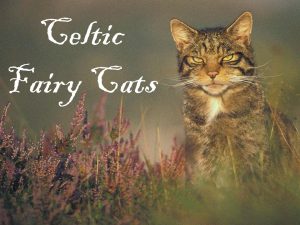 I’m in the process of putting in a fairy garden. At the outset, I did not realize it would be a multi-year process.
I’m in the process of putting in a fairy garden. At the outset, I did not realize it would be a multi-year process.
Last summer, I removed enormous juniper shrub. It was easily 30 feet across. But on July 19th my cats were poisoned. Speculation and conjecture filled the neighborhood with everyone chiming in with a new theory about how or why it happened. Tabby pulled through, but Storm died.
I buried Storm at the site of my future fairy garden. After creating a cat-sized mound over the grave, I told my son, “This will be Storm’s Garden. Her ghost will probably spend all day catching fairies and ripping off their wings.”
The problem with that sentiment is, as onery as Storm was, fairies like cats. In Scotland and Ireland there are legends of cat-sìth—mythical fairy cats. It’s not surprising then, that the day after celebrating Lughnasad more cats entered my life via kittens from the local feral colony.
Two mama cats had litters on property whose owner had a cat killing dog. The owner managed to catch the sole remaining orphaned kitten from one of the litters, but none of the rescues would take the little mite. Not wanting the orphaned kitty to become a snack for her pooch, she posted a picture on Facebook asking for help. I told myself I wasn’t going to it; I’d just lost a cat and wasn’t eager to take in another. Besides, Tabby is territorial and doesn’t like other cats.
By the time I got off work, there still weren’t any takers for the kitten. Sighing I got in the car. I thought I was only picking up ONE kitten. I came home with FIVE!
I managed to find homes for all but one. Black cats are notoriously hard to place and I was left with the little black runt. The universe clearly wanted me to have another cat, so I named him Rune. Being magical, the little bugger changed colors! When he was about 4 months old his coat changed from black to tabby.
This spring, I’ve been burning the juniper’s stump and suckers in preparation for finally finishing Storm’s Garden. Since Storm, Tabby, and Rune all originated from the same feral colony, I’ve decided to plant pussy willows as a nod to the universe and its desire to foist kittens upon me.
Legend of the Pussy Willow
One fine spring day, a rambunctious litter of kittens were playing along the riverbank. The mother cat scolded them repeatedly, warning them to stay away from the water. But delighted with sunshine and bird song, the kittens paid her no mind.

The kittens frolicked and stalked each other, practicing their hunting and fighting skills. They ran, and leapt, and pounced, forming a furry conglomeration of whiskers and tails, paws and purrs. Being too near the riverbank, the jubilant bally of fluff tumbled into the water and was swept away by the current.
The mama cat ran along the river frantically yowling for her kittens as the swift current carried them farther and farther from her. Unable to save them from the rushing water, she feared they would surely drown.
The willows along the shore were moved by her piteous cries. They bent and stretched as the river splashed their bare stalks. Dipping their tips into the current, they managed to catch the little kittens.
One by one, the kittens grabbed the willow stalks and clung to them as they were buoyed to shore. Thus, the willow saved the kittens’ lives and returned the precious babies to their anxiously waiting mama. Ever since, willows have grown soft velvety blooms from their stalks as a reminder of the tiny kittens that clung to them that fateful spring day.
 In addition to pussy willows, I plan on filling my garden with lots of native flowering plants. To do that I’m using the Palouse Prairie Field Guide, which is a delightful little book bursting with color photographs and plant descriptions. It’s arranged by bloom color, making it super easy to find appropriate companion plants for my garden.
In addition to pussy willows, I plan on filling my garden with lots of native flowering plants. To do that I’m using the Palouse Prairie Field Guide, which is a delightful little book bursting with color photographs and plant descriptions. It’s arranged by bloom color, making it super easy to find appropriate companion plants for my garden.
The book is also light-weight and narrow enough to slip in your back pocket, making it handy reference guide for hikers. I fully intend to take it with me when the kids and I do our annual wildflower hike at Kamiak Butte in May.
Locally, the book is available from BookPeople of Moscow.
Celtic Fairy Cats: The Cat-sìth
Magical cats, known as cat-sìth (Irish, cat sí), were the symbol of fearsome warriors. As guardians of the Otherworld, these enormous cats harken from the fairy realm. All black, save for a white spot on their chests, the cat-sìth spend their time haunting the Scottish Highlands and snatching the souls of the newly dead. With its back arched and a hair on end, the cat-sìth makes a fearsome sight. Like all cats, the they are attracted to warmth so those wishing to avoid the cats smother their fires at night.
These independent, intuitive, and intelligent creatures have supernatural abilities that enabled them to speak to humans, foretell the future, and predict the weather. When summoned, they may grant a variety of insights and imbue the seeker with knowledge. The keyword is may. They are incredibly secretive and known to be tricksters.
On Samhain, it’s customary to leave a saucer of milk out for the cat-sìth. Those who do are blessed with abundance in the coming year. Households that neglect to put out a saucer of milk will be cursed and all their cows’ udders will go dry.
Some legends claim the cat-sìth were fairies able to voluntarily transform into a cat and back nine times. But on the ninth time they must remain a cat for the rest of their lives. This may be where the idea of cats having nine lives originated from.
The legend of the cat-sìth was likely inspired by a hybrid of the Scottish Wildcat. Initially thought to be a mythological creature, the Kellas cat was determined to be a distinctive hybrid between Scottish wildcats and domestic house cats after one was successfully snared by a gamekeeper in 1984. These large black felines are only found in Scotland.
The Kellas cat has long, powerful hind legs. The animal snared in 1984 was 15 inches height at the shoulder and 43 inches in length. Other specimens are kept in a museum in Elgin and the Zoology Museum of the University of Aberdeen. Historian Charles Thomas speculates that the Pictish stone at Golspie depicts a Kellas cat. The Golspie stone, now held at the Dunrobin Castle Museum, shows a cat-like creature standing atop a salmon, alluding to the one of the characteristics ascribed to a Kellas cat—fishing.
In Ireland, black cats are harbingers of good luck, wealth, and happiness. A mysterious creature, known as the Bog Cat, roams the shores of Lough Neagh. The Bog Cat is cunning, fast, large, and bestows blessings upon all who cross its path.
Other famous Irish cats are Cat Sí, the King of Cats. These are intelligent and cunning fairies who look exactly like cats. Like their Scottish companions, the Cat Sí are reputed to be terrifying creatures who steal the souls of the recently dead by walking across their graves. This led to cats being chased away from graveyards, just in case there was any truth to the myth and may well be the basis of superstitions regarding black cats and graveyards.
The King of Cats
There once was a crotchety old curmudgeon who lived in a small cottage in County Cork. His wise neighbors advised him to keep the fairy folk happy by leaving a weekly saucer of milk out for the Cat Sí to drink. No matter how much his neighbors plead with him, insisting the Cat Sí kept their crops safe and prevented unwanted spirits from entering the village, the old man refused to participate in the ritual.
“Nonsense!” he proclaimed and vowed prove the tale untrue.
The next night the old man put poison in a cup of milk and set it on the stoop for the Cat Sí. As he was preparing for bed there was a knock on the door. When he opened it, a black cat with a white breast lay dying on his step.
Laughing, the old man dressed headed down to the local pub where he intended to find the cat’s owner and put an end to the tradition of leaving milk out for the Cat Sí. When he reached the pub, he ordered a pint, which turned into another pint, and then a few more. The beer loosened his tongue and he boasted to everyone about what he had done.
The black cat that lived in the pub was curled before the fire. Upon hearing the tale, he jumped up and clawed the cuff of the old man’s trousers.
“That was my father and now I’m the King of Cats!” he yowled.
The new King launched himself at the man, gouging out his eyes with his sharp claws and riding upon his back as the man fled the pub. The vicious brawl continued through streets and alleys until the cat had chased him from the village and left him dead in the potter’s field. The cat snatched the man’s soul just as it left his body to prevent him from ever returning to haunt the village.
Celtic Cat Lore and Shakespeare
Celtic lore also speaks of Grimalkin, a gray cat with magical powers. Many works of art have been dedicated to the Grimalkin. While magical cats are nothing new, it is interesting to note that even Shakespeare mentions the Graymalkin in Macbeth.
“I come, Graymalkin.”
–The first witch’s response when her gray cat calls.
Macbeth, Act I
Graymalkin is an archaic term for a cat. The word derives from “gray” plus “malkin.” The word malkin dates to the late 13th century and is jocular or contemptuous term for a maid-servant, kitchen-servant, slattern, or a loose woman.
Scottish legends refer to the graymalkin as one of the fairy cats that dwell in the highlands. Graymalkin and cats in general were eventually associated with witchcraft. To Christians who feared the supernatural forces outside the church, a cat was a sign that the devil was nearby. This idea became so widespread that women tried as witches in the 16th, 17th and 18th centuries were often accused of having a familiar, frequently a graymalkin.
A Celtic Goddess’ Companion
Ceridwen, the Welsh goddess of wisdom and mother of the bard Taliesin, was attended by white cats who carried out her orders on Earth.
“In ancient times, cats were worshipped as gods; they have not forgotten this.”
–Terry Pratchett
That covers black, white, gray, and tabby. I couldn’t find a single Celtic legend involving ginger cats. If you know any Celtic legends, folklore, or myths involving ginger cats, please share them below.
Brilliant article, but you won’t find references to ginger cats in celtic myth as they where brought to the islands by the Vikings.
enjoyed the article! Thanks
Great piece and very informative. I look forward to more.